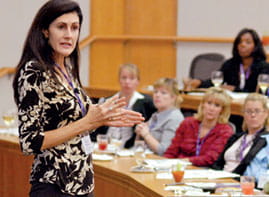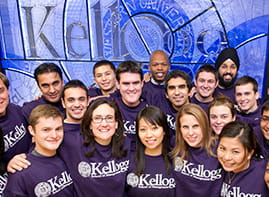12/1/2015 - For most, Gary, Indiana and Flint, Michigan don’t conjure up images of greenery.
For years, post-industrial cities like Flint and Gary have struggled with pollution, unemployment and blight stemming from former factories that closed down as manufacturing dried up in the region. The former industrial sites pose a serious environmental hazard, but there’s also a social aspect: They attract crime and lower property values.
Enter Nicole Chavas ‘15, April Mendez ’16 and Laura Brenner Kimes ‘15, co-founders of Fresh Coast Capital, who developed a market-based, lasting, scalable solution that gets to the root of the problem.
Fresh Coast Capital establishes fast-growing, hybrid poplar tree farms on vacant properties in urban landscapes, which increases the value of the land, produces cleaner air and soil, provides new job opportunities and beautifies neglected spaces. The farms also lay the foundation for future timber-related business and inspire communities.
The hybrid poplars generate financial returns from the value of land appreciation. In three to five years, some of trees will be ready to harvest for pulp and biomass energy. Fresh Coast will harvest the rest in 12 to 15 years for higher-value wood products like veneer and wood paneling.
From concept to harvest
Chavas, Mendez and Kimes visualized their social enterprise project while taking Professor Dave Chen’s impact investing course. (Chen is now Fresh Coast Capital’s board chair.)
Chavas suggested the team develop a solution to the environmental and social issue of brownfields and with Chen’s encouragement, they entered — and won — the
Morgan Stanley Sustainable Investing Challenge. The project received $10,000 and national media coverage, including an interview on MSNBC.
Chavas and Kimes also were named
Youn Impact Scholars, which Chavas says gave them even greater credibility with investors and access to a community of social impact entrepreneurs. “The other scholars have been a great source of advice and support to us as we grow our business,” she said.
At a gathering facilitated by the Youn Scholars network this fall in San Francisco, Chavas and Kimes had the opportunity to meet with Paul Cheng ’03, a current Alumni Youn Scholar and founder of
SharedImpact — a nonprofit focused on improving the financial efficiency and effectiveness of charities and social enterprises.
Cheng provided timely advice “on how to approach soliciting both philanthropic and investment capital [as a social enterprise],” says Chavas. “His experience in the sector will be invaluable for us as we move forward with raising capital.”
Many types of returns
Today, Fresh Coast Capital has two pilot projects in operation: a five-acre tree farm in Flint, the former site of a burnt down nursing home, and another in Gary, previously a neglected baseball field. In 2016, they hope to replicate their success in five or more rustbelt cities, including Kansas City, Missouri.
The company is also researching new revenue streams that can compliment the timber, Chavas says, “including annual crops planted around the trees as well potential opportunities to monetize the storm water management opportunities our projects provide.”
Additionally, residents respond to the idea of having a beautiful, actively maintained green space in their neighborhood and to the work these trees are doing to improve the health of the soil and air.
“The response from neighbors and communities has been extremely positive,” she said. “One neighbor to our Gary farm called our work an ‘answered prayer for the future of Gary.’”
Related reading:






